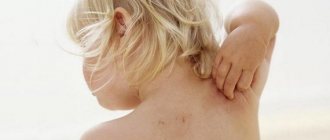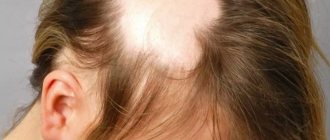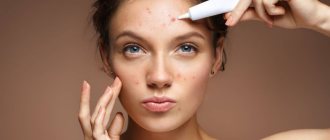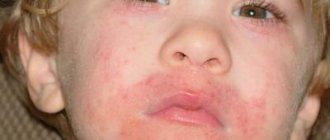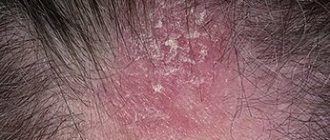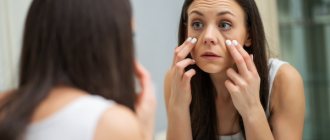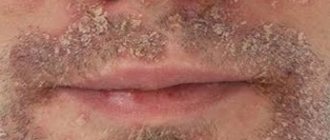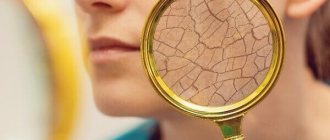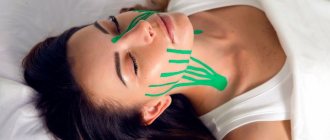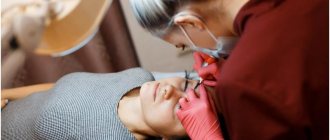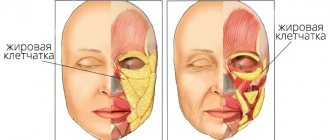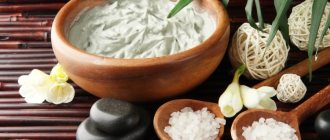Last update: 03/03/2021
Facial allergies often cause severe discomfort - not only physical, but also emotional. This is understandable, because the rash and redness in this area of the body is quite difficult to hide. In addition, dryness and flaking of the skin, burning and itching cause additional inconvenience.
On our website you will learn how to treat allergies on the face, and also find photos of types of allergies.
Facial allergies: causes
The mechanism of development of facial allergies is usually explained by abnormalities in the functioning of the immune system. Sensitization is a complex and highly individual phenomenon, so all people’s reactions to the same substance may be different.
One of the most common causes of facial allergies is heredity. Therefore, if one or both parents have an allergy, it is likely to be passed on to their child.
A tendency to face allergies can appear not only in infancy, but also throughout life. This likelihood occurs especially often after suffering from severe long-term illnesses that weaken the body. A long course of taking medications can also become a serious prerequisite for the appearance and development of allergic reactions on the face.
Recently, another factor has been identified that influences the occurrence of allergies. We are talking about a polluted environment. Also, the tendency to allergic reactions is influenced by chronic fatigue, constant stress, lack of sleep, unbalanced diet and other factors that undermine the body's defenses.
The following are the main causes of allergies on the skin of the face:
- Food allergies on the face are triggered by the consumption of certain foods. The most dangerous for allergy sufferers are nuts, berries, red fruits and vegetables, bee products, eggs, seafood, chocolate, citrus fruits, canned food, and chips.
- Physical contact with an allergen substance. The irritants are usually metal alloys, latex products, household chemicals, and so on. Allergies to cosmetics on the face are very common.
- Contact with animals. The protein produced by dogs, cats and other pets is often an irritant that can cause allergies in sensitive people in the form of rashes and spots on the face and eyes (eyelids).
- Sometimes allergies become the body's response to the use of medications or inhalation of certain substances (dust, pollen, chemical fumes).
- Insect bites. In some people, the bites of mosquitoes, horse flies, wasps and other insects become very swollen, swollen and red. Typically this reaction goes away within one to two days.
- Cold allergy on the face. It can manifest itself from a person being in a cold room or on the street, from wind, contact with cold water, and sometimes from drinking cold drinks and food.
- Allergy on the face to the sun (photodermatitis). It appears from exposure to direct sunlight.
Symptoms of weeping eczema
The first stage of weeping eczema on the hands is characterized by the covering of the skin of the hands with reddened foci of the disease, and the shape and size of the redness do not matter. They are edematous, and their surface is covered with papules (with purulent content) or vesicles (when opened, an exclusively clear liquid is released).
Even if you ignore the itching, the rash may break out on its own. It is serous exudate and its continuous separation that are the main symptoms of weeping eczema, since wet areas appear on the skin.
After some time, the opened papules and vesicles become covered with actively peeling crusts. The main symptom of the disease is a rash of various stages of development. This means that along with new vesicles, old vesicles are present on the skin, and the crusts of opened vesicles are peeling off. All this is accompanied by severe itching, and its strength is such that the patient’s sleep is disturbed, and neurotic disorders are also observed.
If the disease becomes chronic, the skin thickens, scars, and acquires a bluish-red hue. Most often, such areas are characterized by constant peeling and, in acute stages, secondary symptoms of the disease are added. Old lesions may disappear over time, but in most cases the disease reminds itself of itself by pigment spots on the skin.
The disease itself, weeping eczema, is a reaction to internal, but often external irritants. The immune system begins an active attack on the skin, which is the cause of all the symptoms that are inherent in the disease. When examining the immune system, even in the first stages of eczema, it is discovered that it has been weakened and its functioning is incorrect. This is very noticeable if the patient is subjected to improper therapy, since in this case the weeping areas can “capture” a secondary infection.
- Weeping eczema on the legs and arms in most cases affects females, since they very often have hormonal imbalances;
- In addition, citizens whose age is approaching 40 years are also at risk.
- In other cases, both adults and children are at risk of weeping eczema, and the disease in children, in most cases, is associated with an allergic reaction.
What does an allergy on the face look like: types
- Atopic dermatitis. This is one of the most common types of childhood allergies. It appears in the form of red spots, localized mainly on the cheeks and around the mouth. It is also possible for characteristic milky crusts to appear on the eyebrows. With such an allergy, the face itches and swells a little.
- Hives. The main symptom of this allergy is redness of the face, the appearance of rashes reminiscent of nettle burns. The rashes (blisters) rise slightly above the level of healthy skin and are very itchy and itchy.
- Contact dermatitis. Typically, for this type of allergy to occur, a long period of time must pass during which the person is in close contact with the irritant. The allergy manifests itself in the form of weeping erosions, in place of which dry scales then appear.
- Toxidermy. Allergens enter the body through inhalation of toxic substances, as well as through food. The allergy manifests itself in the appearance of macular or papular rashes on the face.
- Quincke's edema. If your face becomes swollen and swollen due to an allergy, it is quite possible that it is Quincke's edema. When it occurs, the features and shape of the face can change beyond recognition. The swelling is very dense, a person feels a strong tension of the skin, but pain rarely occurs. Most often, allergies affect the lips, eyelids and cheeks, causing breathing problems or difficulty.
- Eczema. It is characterized by the appearance of red allergic spots and small bubbles, inside of which there is a clear liquid. Over time, the bubbles burst, and in their place small, weeping wounds appear, which dry out and form scales.
Acne during pregnancy
Acne during pregnancy is considered to be the first symptom of the onset of changes in the female body. If a woman experienced problems with the dermis even before conception, then the problems will worsen while carrying a baby.
Reasons for appearance
Acne on a pregnant woman's body can appear for several reasons:
- Unstable hormonal imbalances. This is associated with changes in the level of a hormone such as progesterone. It supports oil production, which causes acne.
- Dehydration of the body. During pregnancy it happens much faster. If you drink little water, the hormones remain undiluted. This provokes the activation of the sebaceous glands, which contributes to their appearance.
- Neurological pathologies. The process of pregnancy itself is in some way stressful. If complications arise, this affects the woman’s condition. All the girl’s systems react to nervous excitement, which is manifested by large pimples on the body.
- Allergic reactions. During pregnancy, ordinary foods can become allergens as the immune system changes. This contributes to the occurrence of allergic acne.
These reasons are the most important.
What can be a symptom and how to recognize it
The first thing you need to pay attention to is allergies. Red pimples appear on the body, itch and itch
This problem occurs very often in pregnant women, as the body cleanses itself of toxins and other harmful substances and removes them through the skin. At the same time, acne quite often itches all over the body, the reasons for which can be different, and cause pain.
What tests to take
Doctors often prescribe blood tests for hormones, general and biochemical blood tests. It wouldn't hurt to get tested for allergy tests.
How to get rid of it quickly
Treatment of acne during pregnancy first involves proper skin care. You need to do the following:
- walk more often;
- eat as little fatty and fried foods as possible;
- drink as much fluid as possible;
- masks with clay;
- fruit peelings;
- steam baths.
It is forbidden to treat large red pimples on your own, especially with the use of pharmaceutical drugs such as antibiotics, salicylic acid, and steroids. There is no need to worry about hormonal acne in women, as it will go away quickly after childbirth and breastfeeding.
Source: www.PryschamNet.ru
Facial allergies: how to treat and how to diagnose?
Rashes on the face are not a reason to panic. In addition, additional stress can lead to an exacerbation of the disease. However, it is also impossible to let the development of an allergic reaction take its course, as this can lead to the development of serious complications. For example, if allergic weeping wounds get infected, purulent inflammation may appear.
It is not recommended to start treatment without consulting a doctor, as this can lead to serious consequences. Make an appointment with a doctor: treatment should be carried out under the supervision of experienced specialists - an immunologist, an allergist and a dermatologist, a therapist. To determine how to get rid of allergies on the face and what treatment to prescribe, the doctor will conduct a series of tests to determine the allergen. Usually, traditional prick tests are sufficient for this, but in some cases a venous blood test or provocative tests may be required.
If at the moment you cannot get to the hospital to consult with a specialist, do not worry. Follow these guidelines:
- Try to identify the allergen yourself. A rash on the face occurs due to poor-quality cosmetics, exposure to cold, wind, direct sunlight, eating certain foods, and long-term use of strong medications.
- Take an antihistamine. However, without consulting a doctor, it is better not to take medications that you have not tried before. Therefore, take only the medicine that has already been prescribed to you.
- Wash your face with La-Cri gel. This gentle product will gently remove impurities and moisturize the skin. In addition to its cleansing function, this product has anti-inflammatory, antimicrobial and healing effects, so it will be especially useful for allergies.
- Moisturize your skin with hypoallergenic La-Cri cream. This product does not contain fragrances, dyes or fragrances, so it is ideal for inflamed skin. It will relieve allergic itching, reduce peeling, heal small wounds and microcracks. Therapeutic cosmetics cover the skin with a protective layer without leaving an unpleasant sticky film: it can be used as a night cream or a base for cosmetics. “La-Cri” is a non-hormonal remedy, it is not addictive, which means it is suitable for long-term use for allergies.
- To mask redness and rashes from allergies on the face, use only proven products that do not contain aggressive ingredients, such as alcohol. Do not buy new cosmetic products - this may make the situation worse.
Erroneous conclusions
To determine the cause of the rash, you need to figure out what type of acne is bothering the person. They can be inflammatory or non-inflammatory in nature. The danger is that after combing they can leave marks on the body. Under no circumstances should you press them or scratch them too much, because then an infection can get into the wound.
When not to be afraid
If acne appears in teenagers, then you should not be afraid, since such changes are natural for this age. Itching, as a rule, goes away quite quickly, but you can’t do it without consulting a specialist, because even ordinary acne needs proper treatment and prevention.
When is an immediate examination by a dermatologist required?
The appearance of acne can be a consequence of serious diseases in the body. One of these conditions requiring emergency care is poisoning. In addition to the load on the liver, which cannot cope with a large number of toxins, the skin is involved in removing harmful substances. You urgently need to visit a dermatologist in the following cases:
- Minor rash and redness of the skin;
- Multiple ulcers or boils;
- if in addition to the skin rash there is an increase in temperature;
- general weakness;
- swelling of the skin;
- diarrhea;
- vomiting and nausea.
Basic doctor recommendations
At any age, a person can develop rashes on various parts of the body. If they are accompanied by itching, of course, first of all you need to seek professional help, but following the recommendations of specialists, you can not only alleviate the patient’s condition, but also prevent the disease.
- Take care of personal hygiene and choose natural-based products, wash your face with herbal infusion, and often add string and chamomile to the baby’s bath.
- Regularly cleanse the skin of impurities with special cosmetics that have accumulated on it during the day.
- Watch your diet, because a lack of nutrients can negatively affect the condition of the skin. Avoid spicy, fatty and salty foods.
- Lead an active lifestyle, play sports, relax in the fresh air. All this will help avoid stress and depression, improve physical condition and the functioning of the nervous, endocrine and other internal organ systems.
The causes of acne that itch are different, but a timely visit to a dermatologist will help you choose the right course of treatment and not waste time. Mandatory scraping for demodex mites and other tests will clarify the picture of the disease and help quickly relieve the patient from unpleasant itching. Such acne often has unpleasant consequences, so you need to be attentive to the health of your skin.
Source: otprishchei.ru
Severe allergies on the face: what to do and what products to use for treatment?
Facial allergy medications are divided into two categories – corticosteroid (hormonal) and non-hormonal. The drugs of the first group have a powerful effect, but their long-term use can be hazardous to health. Therefore, corticosteroid medications are usually resorted to in case of severe allergic reactions.
Non-hormonal medications for rashes and swelling on the face have a milder effect, so they are used for mild allergies. Also, non-hormonal drugs are most often prescribed to children or people with weakened bodies.
Allergy ointment for face
Ointments have a dense consistency. Due to their oily structure, they not only effectively cope with rashes, but also provide softening and nourishment to the skin.
- Elokom. Glucocorticosteroid ointment that has an antipruritic and antiallergic effect.
- Advantan. Provides fight against swelling, rashes, red spots on the face, and has an antipruritic effect.
- Lokoid. Corticosteroid ointment, the main active ingredient of which is hydrocortisone-17-buritate. Helps cope with itching and swelling of the face.
- Bepanten. A non-hormonal allergy remedy that provides a drying effect. Well suited for combating weeping erosion. The main active ingredient is dexpanthenol.
Allergy cream for face
Compared to allergy ointments, creams have a light and less dense structure. This ensures rapid absorption of the product.
- Dermovate. Glucocorticosteroid cream, the active component of which is clobetasol propionate. The use of the cream provides anti-allergenic and anti-inflammatory effects, relieves swelling, fights itching, burning and hyperemia. Well suited for cases where the face becomes swollen and itchy due to allergies.
- Elidel, Protopic is a non-hormonal anti-inflammatory drug.
- Skin Cap. The main active ingredient of this cream is zinc pyrithioneate. The cream effectively copes with allergic swelling and itching.
Preparations for internal use
In addition to local remedies, treatment of allergies should be accompanied by the use of antihistamines, as well as enterosorbents.
- Enterosgel. Enterosorbent, which ensures rapid removal from the body of toxic substances that cause allergies.
- Cetrin, zodak, zyrtec. The drug is available in the form of drops, syrup, tablets or solution. Has antipruritic and antiexudative effects. The first signs of the action of this medication are noticeable within an hour after administration.
- Telfast. A drug with pronounced antihistamine properties, manifested by blocking H1 receptors. There are side effects such as possible headache, insomnia, and tachycardia.
- Claritin. The active substance in these tablets and syrup is loratadine, which effectively relieves swelling and helps cope with severe swelling. Like many other drugs for internal use against allergies, it has a number of side effects: migraines, dizziness, nausea, rapid heartbeat.
FAQ
Does allergies cause fever or not?
A slight increase in temperature when an allergic component enters the body can be considered normal. Thus, a signal is given that a foreign object has penetrated the cells. A change in temperature of more than one degree should be considered a much more alarming symptom. This indicates the addition of inflammation, and therefore in this case a separate recovery course is prescribed.
What is the name of the allergy blood test?
A blood test for allergies is a test of the blood for the content of immunoglobulin E. Depending on the specific food or other allergens, different indices of this component are identified.
What to apply to an allergic rash?
To ensure effective treatment of allergic rashes, the following remedies are used:
- non-hormonal ointments, for example, Fenistil or Bepanten;
- hormonal compounds, namely Advantan or Elokom;
- Fluorocort, Afloderm and others, used for significant allergic and inflammatory reactions.
The most potent components are Galcinonide and Dermovate ointments, the use of which would be best discussed with a specialist. In addition, treatment of skin allergies in adults can be carried out using Levomekoli, Panthenol and other agents that are more likely to be preventive.
Can you be allergic to coffee?
Instant or brewed coffee is a fairly strong allergen. In the vast majority of cases, the reaction manifests itself in vomiting, severe abdominal pain and frustration. Less commonly, skin changes such as rash or itching may occur. The most rare symptoms are an increase in temperature, as well as Quincke's edema.
How to find out what an adult is allergic to?
To determine a specific allergen, specialized tests are used to identify even the rarest species. In the vast majority of cases, skin tests or blood tests for immunoglobulin E are used. It is recommended to use them all together, which will increase the accuracy of the studies, for example, if a reaction to mascara or shellac is formed.
What could you be allergic to in October?
Allergies in mid-autumn, namely in October, can develop due to three factors
When talking about this, people pay attention to pollen, fungal spores and house dust. It should be borne in mind that it is in October that quinoa, wormwood and ragweed bloom, as a result of interaction with which a rash, swelling of the throat and no less serious symptoms can occur
Some of them are directly related to how a sweet allergy manifests itself.
Allergy to milk, is it possible to have fermented milk products?
Fermented milk products can also not be consumed by everyone, because, for example, cow’s milk contains at least 20 components that have different protein natures. Lipoproteins and alpha-lactalbumin deserve special attention in this regard. This is why if an adult begins to sneeze or cough after eating dairy products, it is recommended that they undergo a special check.
Allergy to hair dye, what to do?
If burning and itching occurs in the face or neck, the affected area of skin is lubricated with compounds such as Fenistil-gel or Psilo balm. Antihistamines are used if a person's condition quickly worsens or if they begin to itch excessively. If symptoms and fever do not go away within several hours, it is recommended to seek medical support.
We recommend reading
Ring-shaped erythema in children and adults
The soles of the feet are covered with red spots
Where does strophulus come from on a child’s skin?
Real causes of facial swelling and treatment methods
La Cree products and their help in the fight against allergies
After the doctor tells you how to treat red spots and other manifestations of allergies on the face, you need to select products that will help restore the aesthetic appearance of the skin. La-Cri brand products, represented by creams, emulsions and gels, will help you with this. These products do not contain hormones, fragrances, harmful dyes, silicones and parabens. The use of La-Cri products is not addictive, so it can be used for a long time.
You can read about rashes on the stomach and ways to deal with them in the following sections.
Experts' opinion
The conducted clinical study proves the high efficiency, safety and tolerability of the product for daily skin care of children and adults with mild and moderate forms of atopic dermatitis and during remission, accompanied by a decrease in the quality of life of patients. As a result of therapy, a decrease in the activity of the inflammatory process, a decrease in dryness, itching and flaking was noted.
Based on the results of joint research, the following information is placed on product packaging: “Recommended by the St. Petersburg branch of the Union of Pediatricians of Russia.”
Sources:
- B.A. Shamov, I.G. Safiullina, A.B. Beshimova, T.B. Shamov, Differential diagnosis of atopic dermatitis, Journal of Practical Medicine, 2011
- Fokina R.A., Atopic dermatitis: stages of development of classification forms, Siberian Medical Journal, 2007
- A.N. Pampura, A.A. Chuslyaeva, Modern approaches to the treatment of atopic dermatitis in children
Photos of allergies in children
Photo album on the diseaseTreatment
Before you start treating acne, you should first find out the cause of its appearance.
You will need to visit a specialist and undergo a number of necessary tests. To quickly get rid of hated pimples, you can follow some specific tips:
- Observe personal hygiene rules. Hand skin care should be done no less often than face care.
- It is required to wear clothes made from natural fabrics. This will allow the skin to breathe.
- Do not use other people's personal hygiene items.
- It is necessary to strengthen the immune system and take multivitamins.
- Exclude fried, salty, and sweet foods from the list of foods you eat.
Medication
You can get rid of acne using ointments.
Experts advise using the following types:
- Betamethasone. This drug quickly penetrates the affected area. The action is quite effective, its effect lasts for 3-6 hours. Can be used 2 times a day.
- Vishnevsky ointment. It is used when pus is detected in the affected areas. It should be applied to the sore spot and secured with an adhesive plaster. The ointment will draw out the pus and relieve swelling and redness. The drug has no contraindications.
- Gel Baziron AS. Perfectly fights acne on the hands. 2 times a day should be applied to the damaged areas. After a few days, the rash will begin to subside.
- Ichthyol ointment. Relieves inflammation, relieves purulent acne. The drug is applied directly to the pimple and secured with a napkin and adhesive tape. After a few hours they can be removed; pus will be visible on the napkin.
At home
You can use some recipes to help get rid of the disease:
- Sea salt. Take a bath, adding 0.5 kg to it. salt. It will perfectly dry and disinfect inflamed skin.
- Honey. You can apply a thin layer of honey to problem areas. Rinse off after the product dries.
- Aloe juice. Wipe damaged areas daily.
- Lemon slices, grated potatoes, viburnum berries. Can be applied to damaged areas, this will effectively relieve inflammation.
- Blue clay. Dilute to a paste and apply to damaged skin.
ethnoscience
There are various effective remedies available.
These include:
- Aloe juice. You should squeeze the juice from the leaf and lubricate the damaged area 2 times a day.
- Raw potatoes. Grate on a fine grater, wrap in gauze, and apply to the sore spot.
- Fresh parsley juice. Squeeze out the juice and wipe the skin 2 times a day.
- Lemon juice. Perfectly helps fight subcutaneous acne. To do this, you will need to mix the juice of half a lemon with 200 grams. water. Lubricate your hands with the resulting liquid.
- Kalanchoe juice. Wash the plant leaf, remove the skin, and lubricate the damaged area 2 times a day.
